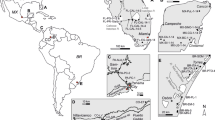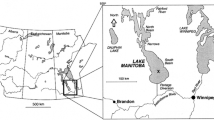Abstract
The geochemistry of ostracode shells and bulk carbonates in a 19-meter sediment core documents at century-scale resolution the evolution of water chemistry in Coldwater Lake, North Dakota, providing a continuous paleohydrologic record of Holocene climate change in the northern Great Plains. A combination of δ18O, δ13C, Mg/Ca and Sr/Ca in ostracode calcite aided by Sr/Ca in bulk carbonates are used to constrain the paleoclimatic reconstructions. A fresh-water phase in the early Holocene, indicated by the absence of Candona rawsoni and low concentrations of Sr/Ca in bulk carbonate, was followed by a sharp increase in salinity between 10 800 and 8900 yr B.P. The climate was predominately dry during the late part of the early Holocene and most of the middle Holocene (8900–5000 yr B.P.), when the lake was very sensitive and recorded a series of dry and wet oscillations. Maximum salinity occurred around 5500 yr B.P. and was followed by a gradual decrease between 5000 and 2400 yr B.P. From 2400 yr B.P. the δ18O, Mg/Ca, and Sr/Ca in the ostracodes indicate generally wet conditions interrupted by a series of lesser salinity and temperature oscillations lasting until 600 yr B.P. Ostracode geochemistry indicates that a warm and dry climate returned at about the time of the Little Ice Age (600–150 yr B.P.). Ostracode δ13C shows a ong-term increasing trend during the Holocene, which suggests that lake productivity and atmospheric CO2 exchange made greater contributions to the hypolimnetic carbon pool as the lake became shallower with time.
Similar content being viewed by others
References
Barnosky, C.W., E. C. Grimm & H. E. Wright, Jr., 1987. Towards a postglacial history of the northern Great Plains: A review of the paleoecologic problems. Annals Carnegie Mus. 56: 259–73.
Bartlein, P. C., T. Webb, III & E. Fleri, 1984. Holocene climate change in the northern Midwest: pollen derived estimates. Quat. Res. 22: 361–374.
Bowler, J. M. & J. T. Teller, 1986. Quaternary evaporites and hydrological changes, Lake Tyrrell, north-west Victoria. Aust. J. Earth Sci. 33: 43–63.
Bryson, R. A., 1966. Air masses, streamlines, and the boreal forest. Geogr. Bull. 8: 228–269.
Bryson, R. A., D. A. Baerreis & W. M. Wendland, 1970. The character of late-glacial and postglacial climatic changes. In W. Dort, Jr & J. Knox Jones, Jr. (eds), Pleistocene and recent environments of the central Great Plains. The University Press of Kansas, Special Publication 3, Lawrence: 53–74.
Chivas, A. R., P. De Deckker & J. M. G. Shelley, 1983. Magnesium, strontium, and barium partitioning in nonmarine ostracode shells and their use in paleoenvironmental reconstructions–a preliminary study. In R. F. Maddocks (ed.), Applications of Ostracoda. University of Houston, Geosciences Department, Houston: 238–249.
Chivas, A. R., P. De Deckker & J. M. G. Shelley, 1985. Strontium content of Ostracods indicates lacustrine palaeosalinity. Nature 316: 251–253.
Chivas, A. R., P. De Deckker & J. M. G. Shelley, 1986a. Magnesium and strontium in non-marine ostracod shells as indicators of palaeosalinity and palaeotemperature. Hydrobiologia 143: 135–142.
Chivas, A. R., P. De Deckker & J. M. G. Shelley, 1986b. Magnesium content of nonmarine ostracod shells: a new palaeosalinometer and palaeothermometer. Palaeogeogr., Palaeoclimatol., Palaeoecol. 54: 43–61.
Chivas, A. R., P. De Deckker, J. A. Cali, A. Chapman, E. Kiss & J. M. G. Shelley, 1993. Coupled stable-isotope and trace-element measurements of lacustrine carbonates as paleoclimatic indicators. In P. K. Swart, K. C. Lohmann, J. McKenzie & S. Savin (eds), Climate Change in Continental Isotopic Records. American Geophysical Union, Washington, DC: 113–122.
Clayton, L., 1962. Glacial geology of Logan and McIntosh Counties, North Dakota. N. Dakota Geol. Surv. Bull. 37: 1–84.
Cole, J. J., N. F. Caraco, G. W. Kling & T. K. Kratz, 1994. Carbon dioxide supersaturation in the surface waters of lakes. Science 265: 1568–1570.
Curtis, J. H. & D. A. Hodell, 1993. An isotopic and trace element study of ostracods from lake Miragoane, Haiti: A 10 500 year record of paleosalinity and paleotemperature changes in the Caribbean. In P. K. Swart, K. C. Lohmann, J. McKenzie S. Savin (eds), Climate Change in Continental Isotopic Records. American Geophysical Union, Washington, DC: 135–152.
De Deckker, P. & R. M. Forester, 1988. The use of ostracods to reconstruct continental palaeoenvironmental records. In P. De Deckker, J.-P. Colin & J.-P. Peypouquet (eds), Ostracoda in the Earth Sciences. Elsevier, Amsterdam: 175–198.
De Deckker, P., A. R. Chivas, J. M. G. Shelley & T. Torgersen, 1988. Ostracod shell chemistry: a new palaeoenvironmental indicator applied to a regressive/transgressive record from the Gulf of Carpentaria, Australia. Palaeogeogr., Palaeoclimatol., Palaeoecol. 66: 231–241.
Delorme, L. D., 1970. Freshwater ostracodes of Canada, part III, family Candonidae. Can. J. of Zool. 48: 1099–1127.
Engstrom D. R. & S. R. Nelson, 1991. Paleosalinity from trace metals in fossil ostracodes compared with observational records at Devils Lake, North Dakota, USA. Palaeogeogr., Palaeoclimatol., Palaeoecol. 83: 295–312.
Forester, R. M., 1987. Late Quaternary paleoclimate records from lacustrine ostracodes. In W. F. Ruddiman & H. E. Wright Jr. (eds), North America and Adjacent Oceans during the Last Deglaciation, The Geology of North America, v. K-3. Geological Society of America, Boulder, Colorado: 261–276.
Fritz, S. C., D. R. Engstrom & B. J. Haskell, 1994.'Little Ice Age' aridity in the North American Great Plains: a high-resolution reconstruction of salinity fluctuations from Devils Lake, North Dakota, USA. The Holocene 4: 69–73.
Fritz, S. C., S. Juggins, R. W. Battarbee & D. R. Engstrom, 1991. Reconstruction of past changes in salinity and climate using a diatom-based transfer function. Nature 352: 706–708.
Hardie, L. A., J. P. Smoot & H. P. Eugster, 1978. Saline lakes and their deposits: a sedimentological approach. Spec. Publs. Int. Assoc. Sedimentol. 2: 7–41.
Haskell, B. J., D. R. Engstrom & S. C. Fritz, 1996. Late Quaternary paleohydrology in the North American Great Plains inferred from the geochemistry of endogenic carbonate and fossil ostracodes from Devils Lake, North Dakota, USA. Palaeogeogr., Palaeoclimatol., Palaeoecol. (in press).
Herczeg, A. L. & R. G. Fairbanks, 1987. Anomalous carbon isotope fractionation between atmospheric CO2 and dissolved inorganic carbon induced by intense photosynthesis. Geochim. Cosmochim. Acta 51: 895–899.
Hostetler, S. W. & L. V. Benson, 1994. Stable isotopes of oxygen and hydrogen in the Truckee River-Pyramid Lake surface-water system. 2. A predictive model of δ18O and δ2H in Pyramid Lake. Limnol. Oceanogr. 39: 356–364.
Juggins, S., R. W. Battarbee & S. C. Fritz, 1994. Diatom/water chemistry transfer functions for salinity, water-level and climate reconstruction. unpublished report, NERC palaeoclimate special topic award GST/02/494.
Kelts, K., 1988. Environments of deposition of lacustrine petroleum source rocks: an introduction. In A. J. Fleet, K. Kelts & M. R. Talbot (eds), Lacustrine Petroleum Source Rocks. Geol. Soc. Am. Spec. Publ. 40: 3–26.
Kennedy, K. A., 1994. Early-Holocene geochemical evolution of saline Medicine Lake, South Dakota. J. Paleolimnology 10: 69–84.
Laird, K. R., S. C. Fritz, E. C. Grimm & P. G. Mueller, 1996. Century-scale paleoclimatic reconstruction from Moon Lake, a closed-basin lake in the northern Great Plains. Limnol. Oceanogr. (in press).
Last, W. M., 1990. Paleochemistry and paleohydrology of Ceylon Lake, a salt-dominated playa basin in the northern Great Plains, Canada. J. Paleolimnology 4: 219–238.
Last, W. M. & D. J. Sauchyn, 1993. Mineralogy and lithostratigraphy of Harris Lake, southwestern Saskatchewan, Canada. J. Paleolimnology 9: 23–39.
Last, W. M. & T. H. Schweyen, 1985. Late Holocene history of Waldsea Lake, Saskatchewan, Canada. Quat. Res. 24: 219–234.
Last, W. M. & L. A. Slezak, 1986. Paleohydrology, sedimentology, and geochemistry of two meromictic saline lakes in southern Saskatchewan. Géogr. Phys. Quat. 60: 5–15.
Lister, G. S., 1988. Stable isotopes from lacustrine ostracoda as tracers for continental palaeoenvironments. In P. De Deckker, J. P. Colin & J. P. Peypouquet (eds), Ostracoda in the Earth Sciences. Elsevier, Amsterdam: 201–218.
Lister, G. S., K. Kelts, K. Z. Chen, Jun-Qing Yu & F. Niessen, 1991. Lake Qinghai, China: closed-basin lake levels and the oxygen isotope record for ostracoda since the latest Pleistocene. Palaeogeogr., Palaeoclimatol., Palaeoecol. 84: 141–162.
McCrea, J. M., 1950. On the isotopic chemistry of carbonates and a paleotemperature scale. J. Chem. Physics 18: 849–857.
McKenzie, J. A., 1985, Carbon isotopes and productivity in the lacustrine and marine environment. In W. Stumm (ed.), Chemical Processes in Lakes. Wiley, New York: 99–118.
Müller, G., G. Irion & U. Föorstner, 1972. Formation and diagenesis of inorganic CaMg carbonates in the lacustrine environment. Naturwissenschaften 59: 158–164.
Palacios-Fest, M. R., A. S. Cohen, J. Ruiz & B. Blank, 1993. Comparative paleoclimatic interpretations from nonmarine ostracodes using faunal assemblages, trace-element shell chemistry and stable isotope data. In P. K. Swart, K. C. Lohmann, J. McKenzie & S. Savin (eds), Climate Change in Continental Isotopic Records. American Geophysical Union, Washington, DC: 179–190.
Radle, N., C. M. Keister & R. W. Battarbee, 1989. Diatom, pollen, and geochemical evidence for the palaeosalinity of Medicine Lake, S. Dakota, during the Late Wisconsin and early Holocene. J. Paleolimnology 2: 159–172.
Romanek, C. S., E. L. Grossman & J. W. Morse, 1992. Carbon isotope fractionation in synthetic aragonite and calcite: effects of temperature and precipitation rate. Geochim. Cosmochim. Acta 56: 419–30.
Schwalb, A., G. S. Lister & K. R. Kelts, 1994. Ostracod carbonate δ18O-and δ13C-signatures of hydrological and climatic changes affecting Lake Neuchâtel, Switzerland, since the latest Pleistocene. J. Paleolimnology 11: 3–17.
Schwarcz, H. & N. Eyles, 1991. Laurentide Ice Sheet extent inferred from stable isotopic composition (O, C) of ostracodes at Toronto, Canada. Quat. Res. 35: 305–320.
Smith, A. J., 1991. Lacustrine Ostracodes as Paleohydrochemical Indicators in Holocene Lake Records of the North-Central United States. Ph. D. Thesis, Brown University.
Smith, A. J., 1993. Lacustrine ostracodes as hydrochemical indicators in lakes of the north-central United States. J. Paleolimnology 8: 121–134.
Stempoort, D. R., T. W. D. Edwards, M. S. Evans & W. M. Last, 1993. Paleohydrology and paleoclimate records in a prairie lake core: mineral, isotope and organic indicators. J. Paleolimnology 8: 135–147.
Stuiver, M., 1975. Climate versus changes in 13C content of the organic component of lake sediments during the late Quaternary. Quat. Res. 5: 251–262.
Valero-Garces, B. L., K. Kelts & E. Ito, 1995. Oxygen and carbon isotope trends and sedimentological evolution of a meromictic and saline lacustrine system: the Holocene Medicine Lake basin, North American Great Plains, USA. Palaeogeogr., Palaeoclimatol., Paleoecol. 117: 253–278.
Vance, R. E., J. J. Clague & R. W. Mathewes, 1993. Holocene paleohydrology of a hypersaline lake in Alberta. J. Paleolimnology 8: 103–120.
Veizer, J., 1983. Trace-elements and isotopes in sedimentary carbonates. In R. J. Reeder (ed.), Carbonates: Mineralogy and Chemistry. Reviews in Mineralogy, Washington DC, 265–300.
von Grafenstein, U., H. Erlenkeuser, J. Müller & A. Kleinmann-Eisenmann, 1992. Oxygen isotope records of benthic ostracods in Bavarian lake sediments. Naturwissenschaften 79: 145–152.
Winter, T. C. & M. Woo, 1990. Hydrology of lakes and wetlands. In M. G. Wolman and H. C. Riggs (eds), Surface Water Hydrology, The Geology of North America v. O-1. Geological Society of America, Boulder, Colorado: 159–184.
Wright, H. E., Jr., 1967. A square-rod piston sampler for lake sediments. J. Sed. Petrol. 37: 975–76.
Wright, H. E. Jr., 1992. Patterns of Holocene climatic change in the midwestern United States. Quat. Res. 38: 129–134.
Xia, J., E. Ito & D. R. Engstrom, 1996a. Oxygen-isotope fractionation between ostracod and water: an experimental determination. Geochim. Cosmochim. Acta (in press).
Xia, J., D. R. Engstrom & E. Ito, 1996b. Variation of stable-isotope and trace-element composition of lacustrine ostracodes from the northern Great Plains: effects of lake water chemistry and seasonal temperature variation. Geochim. Cosmochim. Acta (in press).
Author information
Authors and Affiliations
Rights and permissions
About this article
Cite this article
Xia, J., Haskell, B.J., Engstrom, D.R. et al. Holocene climate reconstructions from tandem trace-element and stable-isotope composition of ostracodes from Coldwater Lake, North Dakota, U.S.A.. Journal of Paleolimnology 17, 85–100 (1997). https://doi.org/10.1023/A:1007921328712
Issue Date:
DOI: https://doi.org/10.1023/A:1007921328712




